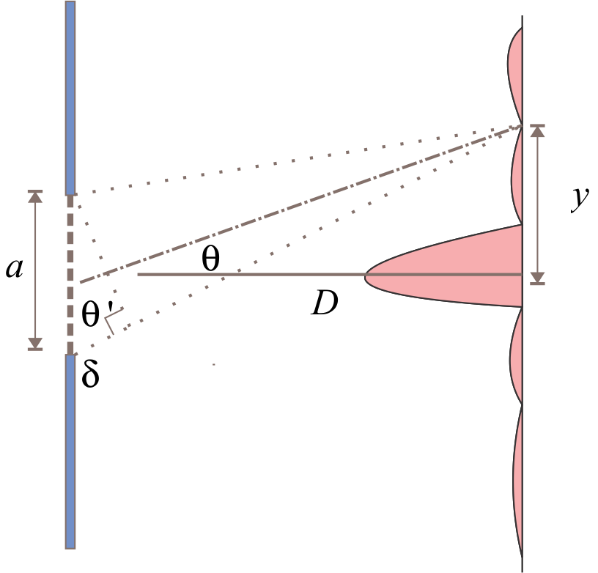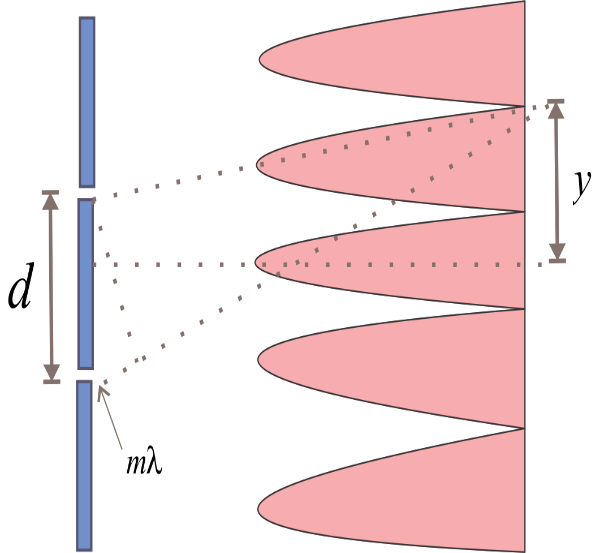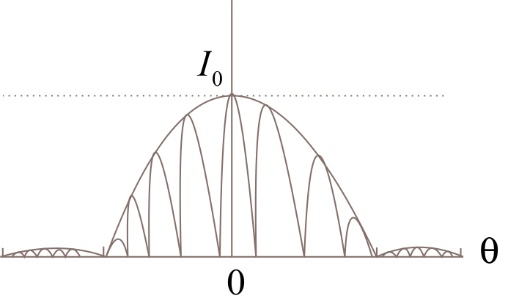
What should be the width of each slit to obtain $10$ maxima of double slit interference pattern within the central maximum of single slit diffraction pattern?
Answer
121.8k+ views
Hint: This is a complicated question the students should have a deep knowledge on the single and double slit experiment to understand the question. We should know about the relation between the double and single slit experiment so that we can understand the question properly.
Complete step by step answer
Single slit diffraction: Single slit diffraction occurs in a single slit experiment where light waves from a source passes through a single slit of width ‘w’ which is in the order of the wavelength of the light wave passing through it to get a distinctive pattern called diffraction pattern.
Double slit experiment: double slit diffraction occurs in a when where light waves from a source passes through a two slits of width ‘w’ which is in the order of the wavelength of the light wave passing through it to get a diffraction pattern.
When the double slit in Young’s experiment is replaced by a single narrow slit (illuminated by a monochromatic source), a broad pattern with a central bright region is observed. On both sides, there are alternate dark and bright regions, the intensity becoming weaker away from the centre the angular size of the central maximum increases when the slit width decreases. The double-slit experiment, is actually a superposition of single-slit diffraction from each slit or hole.


Single slit experiment Double slit experiment
In the diagram,
a and d are the width of the slit.
y is the central maximum.
The angular width of the central maximum of single slit diffraction is $2\theta = \dfrac{{2\lambda }}{a}$
Where,
$\lambda $ is the wavelength
$a$ is the width of the slit
The angular width of the central maximum of double slit diffraction is $2\theta = \dfrac{\lambda }{d}$
$\lambda $ is the wavelength
$d$ is the width of the slit
The angular width of the central maximum of single slit diffraction is $2\theta = \dfrac{{2\lambda }}{a}{\text{ }} \to {\text{1}}$
Width of each slit to obtain $10$ maxima of double slit interference pattern within the central maximum of single slit diffraction pattern $ \Rightarrow 2\theta = 10 \times \dfrac{\lambda }{d}{\text{ }} \to {\text{2}}$
The double slit interference pattern of 10 maxima (The envelope shows the single slit experiment)

We have to find the width of each slit to obtain $10$ maxima of double slit interference pattern within the central maximum of single slit diffraction pattern.
Equate 1 and 2
$ \Rightarrow \dfrac{{2\lambda }}{a} = 10 \times \dfrac{\lambda }{d}$
$ \Rightarrow a = \dfrac{d}{5}$
$a$ is the width of the single slit.
$d$ is the width of the double slit.
We have to find the width of both single and double slit which have the same width.
So, let us take the width of slit as $a$ in common.
$ \Rightarrow a = \dfrac{1}{5}$
$ \Rightarrow a = 0.2mm$
Note: Students should be aware that here the width of the slit is written in millimetres. Generally we write the measurement of slit width in millimetres, we follow the same when we do the problem.
Complete step by step answer
Single slit diffraction: Single slit diffraction occurs in a single slit experiment where light waves from a source passes through a single slit of width ‘w’ which is in the order of the wavelength of the light wave passing through it to get a distinctive pattern called diffraction pattern.
Double slit experiment: double slit diffraction occurs in a when where light waves from a source passes through a two slits of width ‘w’ which is in the order of the wavelength of the light wave passing through it to get a diffraction pattern.
When the double slit in Young’s experiment is replaced by a single narrow slit (illuminated by a monochromatic source), a broad pattern with a central bright region is observed. On both sides, there are alternate dark and bright regions, the intensity becoming weaker away from the centre the angular size of the central maximum increases when the slit width decreases. The double-slit experiment, is actually a superposition of single-slit diffraction from each slit or hole.


Single slit experiment Double slit experiment
In the diagram,
a and d are the width of the slit.
y is the central maximum.
The angular width of the central maximum of single slit diffraction is $2\theta = \dfrac{{2\lambda }}{a}$
Where,
$\lambda $ is the wavelength
$a$ is the width of the slit
The angular width of the central maximum of double slit diffraction is $2\theta = \dfrac{\lambda }{d}$
$\lambda $ is the wavelength
$d$ is the width of the slit
The angular width of the central maximum of single slit diffraction is $2\theta = \dfrac{{2\lambda }}{a}{\text{ }} \to {\text{1}}$
Width of each slit to obtain $10$ maxima of double slit interference pattern within the central maximum of single slit diffraction pattern $ \Rightarrow 2\theta = 10 \times \dfrac{\lambda }{d}{\text{ }} \to {\text{2}}$
The double slit interference pattern of 10 maxima (The envelope shows the single slit experiment)

We have to find the width of each slit to obtain $10$ maxima of double slit interference pattern within the central maximum of single slit diffraction pattern.
Equate 1 and 2
$ \Rightarrow \dfrac{{2\lambda }}{a} = 10 \times \dfrac{\lambda }{d}$
$ \Rightarrow a = \dfrac{d}{5}$
$a$ is the width of the single slit.
$d$ is the width of the double slit.
We have to find the width of both single and double slit which have the same width.
So, let us take the width of slit as $a$ in common.
$ \Rightarrow a = \dfrac{1}{5}$
$ \Rightarrow a = 0.2mm$
Note: Students should be aware that here the width of the slit is written in millimetres. Generally we write the measurement of slit width in millimetres, we follow the same when we do the problem.
Recently Updated Pages
How to find Oxidation Number - Important Concepts for JEE

How Electromagnetic Waves are Formed - Important Concepts for JEE

Electrical Resistance - Important Concepts and Tips for JEE

Average Atomic Mass - Important Concepts and Tips for JEE

Chemical Equation - Important Concepts and Tips for JEE

Concept of CP and CV of Gas - Important Concepts and Tips for JEE

Trending doubts
JEE Mains 2025: Check Important Dates, Syllabus, Exam Pattern, Fee and Updates

JEE Main Login 2045: Step-by-Step Instructions and Details

JEE Main Chemistry Question Paper with Answer Keys and Solutions

JEE Main Exam Marking Scheme: Detailed Breakdown of Marks and Negative Marking

JEE Main 2023 January 24 Shift 2 Question Paper with Answer Keys & Solutions

JEE Main Chemistry Exam Pattern 2025

Other Pages
JEE Advanced Marks vs Ranks 2025: Understanding Category-wise Qualifying Marks and Previous Year Cut-offs

JEE Advanced 2025: Dates, Registration, Syllabus, Eligibility Criteria and More

Learn About Angle Of Deviation In Prism: JEE Main Physics 2025

JEE Main 2025: Conversion of Galvanometer Into Ammeter And Voltmeter in Physics

Dual Nature of Radiation and Matter Class 12 Notes: CBSE Physics Chapter 11

Electric field due to uniformly charged sphere class 12 physics JEE_Main




